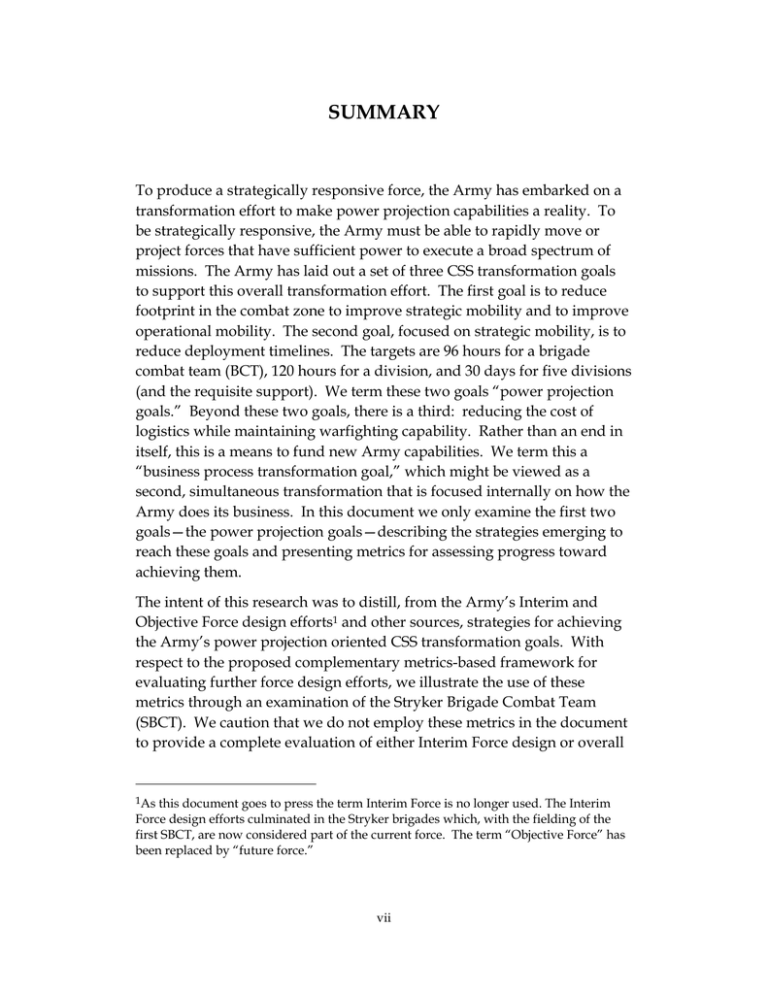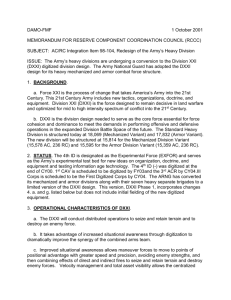SUMMARY
advertisement

SUMMARY To produce a strategically responsive force, the Army has embarked on a transformation effort to make power projection capabilities a reality. To be strategically responsive, the Army must be able to rapidly move or project forces that have sufficient power to execute a broad spectrum of missions. The Army has laid out a set of three CSS transformation goals to support this overall transformation effort. The first goal is to reduce footprint in the combat zone to improve strategic mobility and to improve operational mobility. The second goal, focused on strategic mobility, is to reduce deployment timelines. The targets are 96 hours for a brigade combat team (BCT), 120 hours for a division, and 30 days for five divisions (and the requisite support). We term these two goals “power projection goals.” Beyond these two goals, there is a third: reducing the cost of logistics while maintaining warfighting capability. Rather than an end in itself, this is a means to fund new Army capabilities. We term this a “business process transformation goal,” which might be viewed as a second, simultaneous transformation that is focused internally on how the Army does its business. In this document we only examine the first two goals—the power projection goals—describing the strategies emerging to reach these goals and presenting metrics for assessing progress toward achieving them. The intent of this research was to distill, from the Army’s Interim and Objective Force design efforts1 and other sources, strategies for achieving the Army’s power projection oriented CSS transformation goals. With respect to the proposed complementary metrics-based framework for evaluating further force design efforts, we illustrate the use of these metrics through an examination of the Stryker Brigade Combat Team (SBCT). We caution that we do not employ these metrics in the document to provide a complete evaluation of either Interim Force design or overall 1As this document goes to press the term Interim Force is no longer used. The Interim Force design efforts culminated in the Stryker brigades which, with the fielding of the first SBCT, are now considered part of the current force. The term “Objective Force” has been replaced by “future force.” vii CSS transformation efforts. Instead, we aim to provide a common understanding of the strategies the Army is employing to improve power projection capability from a CSS perspective and to spur additional application of these strategies. In many cases, Army personnel have not “purposely” applied these strategies, but have come up with innovative ideas that reflect them. It is from these ideas that we derived the underlying strategies. The value of this document is that some of these ideas are not universally known in the Army, nor are the principles often widely understood, which is necessary for their broader application across functional areas. This document should help communicate and explain the strategies and expand the breadth of debate on the right approach to CSS transformation. CSS TRANSFORMATION METRICS Footprint metrics should communicate how well CSS transformation actions are contributing to increased operational and strategic mobility. Time-phased deployment footprint affects strategic mobility. From a strategic mobility perspective, it is critical to know how many people and how much equipment must be moved to achieve initial employment capability at increasing levels of combat power—SBCT/unit of action (UA), division, and “corps-like capabilities”/unit of employment (UE). Because CSS footprint in maneuver forces also affects operational mobility, there is a second reason to measure CSS footprint at the brigade and division levels (or the UA in the Objective Force). Thus footprint should be measured at these three echelons, in terms of achieving initial operating capability, and categorized by function: combat, combat support, and CSS. Then traditional metrics can be used to evaluate each category: the number of personnel, the weight of the equipment, and the square footage (and/or possibly cube) of equipment. Deployment time metrics should reveal the effects of the three dimensions of deployment time: footprint, process throughput, and force positioning. STRATEGIES FOR ACHIEVING CSS TRANSFORMATION Since the Army began its Transformation Campaign, the Combined Arms Support Command (CASCOM), the Army Materiel Command (AMC), the viii Army’s G-4 staff, and CSS personnel in the Army’s major force-providing commands have been developing doctrinal, force design, policy, and technological concepts for achieving the CSS transformation goals. From these concepts, we have seen five strategies emerge for achieving the CSS transformation goals. The first strategy, demand reduction, is about reducing support requirements by reducing the demand of the forces being supported (to include CSS personnel and equipment) or reducing the amount of CSS personnel and equipment necessary to provide a given level of support using a given concept of support. We characterize the ways to reduce the demand for CSS resources as four substrategies. Most typically, people think of reducing demands on the logistics system through better fuel efficiency, smart munitions, and better reliability. We term this type of reduction platform efficiency. Significant attention is also being given to improving force efficiency—reducing footprint through initiatives that require fewer assets or platforms to execute a mission, such as combat multipliers, platform commonality, or common munitions. Besides increasing the efficiency of a force from an equipment viewpoint, personnel efficiency can also improve. Finally, demand reduction is sometimes a product of a change in mission focus that allows a force to more efficiently optimize for a portion of the operational spectrum. The second strategy is modular maneuver unit support, which limits organic support capacity to that which is essential for combat operations. All but only those capabilities absolutely essential to an organization during all phases of operations are made organic to the organization—no “luxuries,” just-in-case capabilities, capabilities that are only needed periodically, or capabilities to execute tasks that can be deferred or scheduled outside of combat operations and that can be provided through reach without undue risk are present. These capabilities, also important at the right time in an operation or if the mission dictates, can be phased in as the operation evolves, but keeping such capabilities as separate modules enables the ability to keep combat maneuver forces lean when this is the overriding concern, such as for rapid deployment or combat maneuver. It is critical to note that every modular support initiative requires a resourced plan for providing the removed capability when needed. ix The third strategy is the continued implementation of distribution-based logistics (DBL), which aims to provide equal or better CSS capabilities with fewer unit resources and supplies through better distribution rather than through stockpiles of supplies held and carried around by units. It exchanges “warehousing” capacity for frequent, consistent flows. The faster and more reliable that distribution processes become across a range of environments and scenarios, the more the Army can reduce the need for inventory in maneuver units and the combat zone. The DBL substrategies described in the main body of the report reflect means for improving the speed and reliability of distribution and for making these capabilities robust across as great a range of environments and scenarios as possible. They include: process improvement, logistics situational awareness, modular and intermodal containers, common platforms with integrated load-handling systems, configured loads, precision aerial delivery, and increased intratheater lift assets. The fourth strategy, improved deployment capabilities, enables faster deployment for a given level of footprint. Three substrategies for improving deployment capability have emerged. The first we term lift capacity, which consists of lift platforms—both new systems and increases in legacy lift. The second is infrastructure improvement at garrison locations and intermediate support bases to improve the throughput of nodes as well as to provide new nodes. The third consists of process improvement. Forward positioning, the fifth strategy, is about moving forces or equipment closer to anticipated deployment destinations. Under forward positioning there are two substrategies. The first is the prepositioning of equipment on ships or on land where it is at or can quickly get to anticipated contingency locations. The second is the forward basing of units, such as the SBCT, closer to potential areas of operations, whether permanently, on a rotational basis, or temporarily. The chart to the right brings the footprint reduction strategies, deployment capabilities, and forward positioning strategies together in a tradespace illustration to show how together they can help drive achievement of the CSS transformation goals. In this example, a brigadesized unit has to deploy to Skopje, which has a working maximum on the ground (MOG) of 3. Let us walk through the three dimensions. The first data point, indicated by a black triangle, shows the air deployment time, x Example: Deployment Capabilities (Lift/Process Times/MOG), Force/Equipment Positioning (Lewis/Germany/Prepo), and Footprint (BCT Type) Combine to Drive Deployment Timelines Estimated Deployment Times to Skopje 28 Mech, 40 C -17s, C urrent process times S B C T, 40 C -17s, C urrent process times Dep loym ent Closure T im e 24 Mech B C T S B C T, 20 C -17s, C urrent process times S B C T, 30 C -17s, 40% cut in process times or w orking MOG of 5 20 S B C T, 80 C -17s, C urrent process times S B C T S trykers+, 40 C -17s, C urrent process times Footprint reduction 16 SBCT 12 Forw 8 4 asing ard b Airlift increase S elected prepo P rocess improvement or increase in w orking MOG S trykers only (P repo TW V s & sustainment) 0 Ram stein Ft. Lew is Pea cetim e B ase RAND ARROYO CENTER 07/02/2003 31 about 25 days, for a heavy BCT allocated 40 C-17s. Holding other factors constant, we see that in this case the change in footprint from moving to the SBCT cuts the time substantially to an estimate of 13.6 days, as shown by the gray triangle. Again, holding other factors constant, doubling the airlift to 80 C-17s substantially improves the speed to an estimate of 7.6 days. Alternatively, forward basing can reduce the time to 6.7 days and dramatically reduces the airlift requirement to just 20 C-17s, the limit of useable airlift given the distance and working MOG constraint. Thus not only can forward basing improve deployment speed, it can reduce the consumption of a constrained asset—strategic airlift. Another alternative would be to selectively preposition the SBCT’s soft-skinned tactical wheeled vehicles (TWVs) and initial supply of consumable materiel, enabling a 6-day deployment time with 40 C-17s. While they consume about 60 percent of the needed airlift missions, the cost is relatively low, with the TWVs comprising only about 10 percent of the cost of an SBCT. Finally, improving offload and total aerial port of debarkation (APOD) aircraft turnaround time, combined with forward basing, would enable a 4-day deployment time with about 30 C-17s. Improved process time would have less effect with CONUS basing, because leveraging the xi improvement to reduce deployment time would require a substantial increase in airlift. At brigade level, a good story is emerging for CSS transformation from the Interim Force and Objective Force development processes. Through the application of five complementary strategies, progress is being made toward transforming CSS in maneuver forces, and insights gained during SBCT development are being leveraged in Objective Force planning. Applying appropriate metrics to completed design initiatives documents this success. Modular support, DBL, and demand reduction have been applied to the SBCT—producing unit designs with CSS footprint, overall footprint, and deployment times about half that of legacy heavy forces. We should note, however, that the applications of these strategies are still being refined, and some of the technology and operational concepts necessary to enable the full realization of these strategies are still being developed, funded, and implemented. Further good news is that the same general principles appear to offer significant opportunity in echelons above division (EAD). However, this is where the current good news ends. Within units, changes have been made by individual branches, but initiatives that could change the required and resourced number of units have yet to be implemented on a large scale. The BCT designs have been under the control of one entity—TRADOC— and they have been implemented with top-down edicts that forced change. Similarly, the logistics force designs were changes that could be made within the control of one organization—the logistics branch chiefs and CASCOM. However, EAD requirements are the product of a process in which everyone has a hand. Perhaps there are lessons here from the BCT design efforts and CASCOM force design efforts. Much work remains, but it seems that effective strategies are emerging for achieving CSS transformation goals. Progress to date demonstrates their potential but, combined with analyses, also suggests the need for all five. The CSS community will have to pursue DBL and modular support and advocate for improved deployment capabilities and new force-positioning options. In conjunction, the Army must push demand reduction through improvements in platform and force efficiency to achieve its power projection goals. It is hoped that more clearly illuminating these strategies xii will trigger the further development of specific transformative ideas. Additionally, using well-designed metrics to analyze the costs and benefits would bring rigor to the force development process, ensuring that it stays on track to produce a power projection Army. xiii




